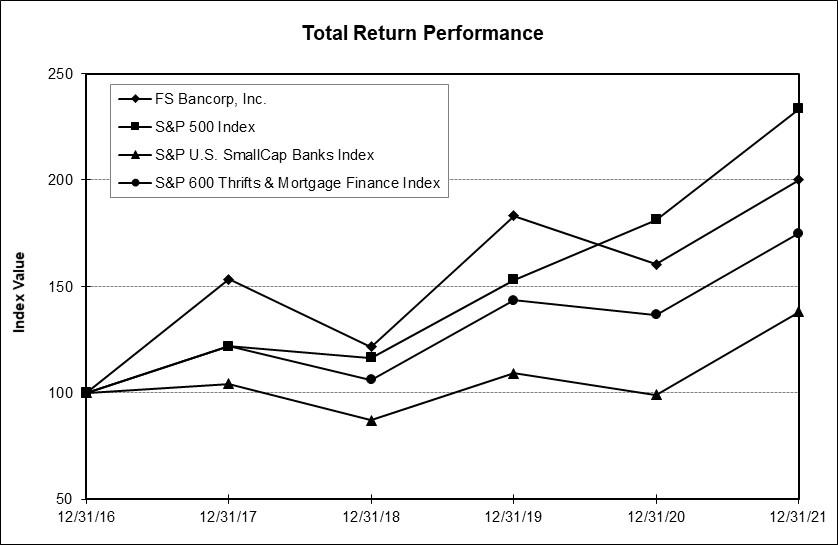there were 107 PPP loans outstanding totaling $24.2 million, as compared to 423 PPP loans totaling $62.1 million at December 31, 2020.
The principal executive offices of the Company are located at 6920 220th Street SW, Mountlake Terrace, Washington 98043 and the main telephone number is (425) 771-5299.
Market Area
The Company conducts operations, including loan and/or deposit services out of its headquarters, 10 loan production offices (six of which stand alone), 21 full-service bank branches in the Puget Sound region of Washington, and one stand-alone loan production office in Eastern Washington. The headquarters is located in Mountlake Terrace, in Snohomish County, Washington. The five stand-alone loan production offices in the Puget Sound region are located in Puyallup and Tacoma, in Pierce County, Bellevue, in King County, Port Orchard, in Kitsap County, Everett, in Snohomish County, and the one in Eastern Washington located in the Tri-Cities (Kennewick), in Benton County, Washington. The 21 full-service bank branches are located in the following counties: three in Snohomish, two in King, two in Clallam, two in Jefferson, two in Pierce, five in Grays Harbor, two in Thurston, one in Lewis, and two in Kitsap County.
The primary market area for business operations is the Seattle-Tacoma-Bellevue, Washington Metropolitan Statistical Area (the “Seattle MSA”). Kitsap, Clallam, Jefferson, Thurston, Lewis, and Grays Harbor counties, though not in the Seattle MSA, are also part of the Company’s market area. This overall region is typically known as the Puget Sound region. The population of the Puget Sound region as estimated by Puget Sound Regional Council was 4.3 million in 2021, over half of the state’s population, representing a large population base for potential business. The region has a well-developed urban area in the western portion along Puget Sound, with the north, central and eastern portions containing a mixture of developed residential and commercial neighborhoods and undeveloped, rural neighborhoods.
The Puget Sound region is the largest business center in both the State of Washington and the Pacific Northwest. Currently, key elements of the economy are aerospace, military bases, clean technology, biotechnology, education, information technology, logistics, international trade and tourism. The region is well known for the long presence of The Boeing Corporation and Microsoft, two major industry leaders, and for its leadership in technology. Amazon.com has expanded significantly in the Seattle downtown area. The workforce in general is well-educated and strong in technology. Washington State’s location with regard to the Pacific Rim, along with a deep-water port has made international trade a significant part of the regional economy. Tourism has also developed into a major industry for the area, due to the scenic beauty, temperate climate and easy accessibility.
King County, which includes the city of Seattle, has the largest employment base and overall level of economic activity. Six of the largest employers in the state are headquartered in King County including Microsoft Corporation, University of Washington, Amazon.com, King County Government, Starbucks, and Swedish Health Services. Pierce County is the second most populous county in the state and its economy is also well diversified with the presence of military related government employment (Joint Base Lewis-McChord), along with health care (the MultiCare Health System and the Franciscan Health System). In addition, there is a large employment base in the economic sectors of shipping (the Port of Tacoma) and aerospace employment (Boeing). Snohomish County to the north has an economy based on aerospace employment (Boeing), health care (Providence Regional Medical Center), and military (the Everett Naval Station) along with additional employment concentrations in biotechnology, electronics/computers, and wood products.
According to 2021 economic research estimates, the median household income for King County was $103,000, compared to $79,000 for the State of Washington, and $66,000 for the United States.
The United States Navy is a key element for Kitsap County’s economy. The United States Navy is the largest employer in the county, with installations at Puget Sound Naval Shipyard, Naval Undersea Warfare Center Keyport and Naval Base Kitsap (which comprises former Naval Submarine Base Bangor, and Naval Station Bremerton). The largest private employers in the county are the Harrison Medical Center and Port Madison Enterprises. Clallam County depends on agriculture, forestry, fishing, outdoor recreation and tourism. Jefferson County’s largest private employer is Port Townsend Paper Mill and the largest employer overall (private and public) is Jefferson Healthcare.
